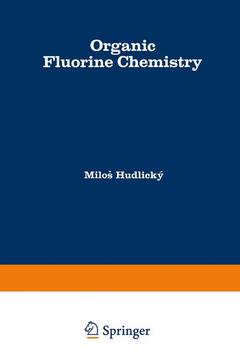Description
Organic Fluorine Chemistry, Softcover reprint of the original 1st ed. 1971
Author: Hudlicky Milos
Language: English
Subject for Organic Fluorine Chemistry:
Approximative price 52.74 €
In Print (Delivery period: 15 days).
Add to cart
Publication date: 03-2012
200 p. · 15.2x22.9 cm · Paperback
200 p. · 15.2x22.9 cm · Paperback
Description
/li>Contents
/li>
The present book is essentially based on the lectures on the chemistry of organic compounds of fluorine that I gave in 1969 at Virginia Polytechnic Institute in Blacksburg, Virginia, as a graduate course. References to material published to the end of 1969 are included. The book is primarily meant to provide the background for such a course, and, at the same time, to be a brief survey of recent knowledge in, and an introduction to deeper study of, this area of chemistry, which has been treated in a number of com prehensive monographs. I would like to thank Professor S. C. Cohen, Syracuse University, for the compilation of the data on mass spectra and nuclear magnetic res onance spectra, and my son, Tomas Hudlicky, and my daughter, Eva Hudlickci, for their help with the indexes. MILOS HUDLICKY February 13, 1970 Virginia Polytechnic Institute and State University Blacksburg, Virginia vii Contents CHAPTER 1. Introduction ......................................................... 1 Development of Fluorine Chemistry ......................................... .
1. Introduction.- Development of Fluorine Chemistry.- Handling of Fluorine, Hydrogen Fluoride, and Fluorine Compounds.- Equipment and Apparatus.- 2. Fluorinating Agents.- Hydrogen Fluoride.- Fluorine.- Inorganic Fluorides.- Organic Fluorides.- 3. Nomenclature of Organic Fluorine Compounds.- 4. Introduction of Fluorine into Organic Compounds.- Addition of Hydrogen Fluoride to Olefins.- Addition of Hydrogen Fluoride to Acetylenes and Other Unsaturated Systems.- Addition of Fluorine to Olefins.- Addition of Fluorine to Other Unsaturated Systems.- Addition of Halogen Fluorides and Organic Fluorides to Olefins.- Replacement of Hydrogen by Fluorine.- Replacement of Halogens by Fluoride.- Replacement by Means of Hydrogen Fluoride.- Replacement by Means of Antimony Fluorides.- Replacement by Means of Silver Fluoride.- Replacement by Means of Mercury Fluorides.- Replacement by Means of Potassium Fluoride.- Replacement by Means of Other Fluorides.- Replacement of Oxygen by Fluorine.- Cleavage of Ethers and Epoxides.- Cleavage of Sulfonic Esters.- Replacement of Hydroxylic Group by Fluorine.- Replacement of Carbonyl Oxygen by Fluorine.- Conversion of Carboxylic Group to Trifluoromethyl Group.- Replacement of Nitrogen by Fluorine.- 5. Analysis of Organic Fluorine Compounds.- Physical Methods of Analysis of Fluorine Compounds or Their Mixtures.- Infrared Spectroscopy.- Mass Spectroscopy.- Nuclear Magnetic Resonance Spectroscopy.- Separation of Mixtures and Purification of Components.- Qualitative Tests for Fluorine.- Detection of Elemental Fluorine.- Detection of Fluoride Ion.- Detection of Fluorine in Organic Compounds.- Quantitative Determination of Fluoride.- Volumetric Determination.- Determination Using Fluoride Membrane Electrode.- Mineralization of Fluorine in Organic Compounds.- Decomposition with Alkalies.- Combustion in Oxygen.- Determination of Other Elements in Organic Fluorine Compounds.- Special Analyses.- 6. Properties of Organic Fluorine Compounds.- Physical Properties.- Melting Points.- Boiling Points.- Density.- Refractive Index.- Dielectric Constant.- Surface Tension.- Viscosity.- Solubility.- Physicochemical Properties.- Biological Properties.- 7. Practical Applications of Organic Fluorine Compounds.- Refrigerants, Propellants, and Fire Extinguishers.- Plastics and Elastomers.- Monomers.- Polymerization.- Processing of Polymers.- Applications of Plastics and Elastomers.- Fluorinated Compounds as Pharmaceuticals.- Other Uses of Fluorinated Compounds.- 8. Reactions of Organic Fluorine Compounds.- Factors Governing the Reactivity of Organic Fluorine Compounds.- Inductive Effect.- Hyperconjugation.- Mesomeric Effect.- Steric Effects.- Important Features in the Reactivity of Organic Fluorine Compounds.- Reduction.- Catalytic Hydrogenation.- Reduction with Complex Hydrides.- Reduction with Metals and Metallic Compounds.- Reduction with Organic Compounds.- Oxidation.- Oxidations with Oxygen.- Oxidations with Oxidative Reagents.- Oxidations of Fluoro-olefins.- Oxidations of Fluorinated Aromatics.- Oxidation of Nitrogen and Sulfur Compounds.- Anodic Oxidation.- Electrophilic Reactions.- Halogenation.- Addition of Halogens across Multiple Bonds.- Replacement of Hydrogen by Halogens.- Cleavage of the Carbon Chain by Halogens.- Addition of Hydrogen Halides across Multiple Bonds.- Replacement of Oxygen- and Nitrogen-Containing Functions by Halogens.- Replacement of Fluorine by Other Halogens.- Nitration.- Nitrosation.- Sulfonation.- Acid-Catalyzed Syntheses (Friedel-Crafts Reaction).- Acid-Catalyzed Additions.- Acid-Catalyzed Substitutions.- Nucleophilic Substitutions.- Esterification and Acetalization.- Hydrolysis.- Hydrolysis of Nonfluorinated Parts of Fluorinated Molecules.- Hydrolytic Displacement of Single Fluorine Atoms.- Hydrolysis of Difluoromethylene Group.- Hydrolysis of Trifluoromethyl Group.- Hydrolysis of Perfluoro Compounds.- Fluoroform Reaction.- Alkylations.- Alkylations at Oxygen.- Alkylations at Sulfur.- Alkylations at Nitrogen and Phosphorus.- Alkylations at Carbon.- Arylations.- Arylations at Oxygen.- Arylations at Sulfur.- Arylations at Nitrogen.- Arylations at Carbon.- Acylations.- Acylations at Oxygen.- Acylations at Sulfur.- Acylations at Nitrogen.- Acylations at Carbon.- Syntheses with Organometallic Compounds.- The Grignard Syntheses.- Grignard Reagents as Organic Substrate.- Fluorinated Grignard Reagents.- Perfluorinated Grignard Reagents.- Organolithium Compounds.- Organolithium Compounds as Organic Substrate.- Fluorinated Organolithium Compounds.- Perfluorinated Organolithium Compounds.- Organozinc Compounds.- Organomercury Compounds.- Organocopper Compounds.- Organometalloids.- Base-Catalyzed Condensations.- Additions.- Nucleophilic Additions to Fluorinated Olefins.- Additions of Alcohols and Phenols.- Additions of Mercaptans and Thiophenols.- Additions of Ammonia and Amines.- Free-Radical-Type Additions.- Linear Additions.- Cycloadditions.- Formation of Three-Membered Rings.- Formation of Four-Membered Rings.- Formation of Five-Membered Rings.- Formation of Six-Membered Rings (Diels-Alder Reaction).- Eliminations.- Dehalogenations.- Dehydrohalogenations.- Decarboxylations.- Dehydration.- Molecular Rearrangements.- Pyroreactions.- 9. Fluorinated Compounds as Chemical Reagents.- References.- Author Index.
© 2024 LAVOISIER S.A.S.




